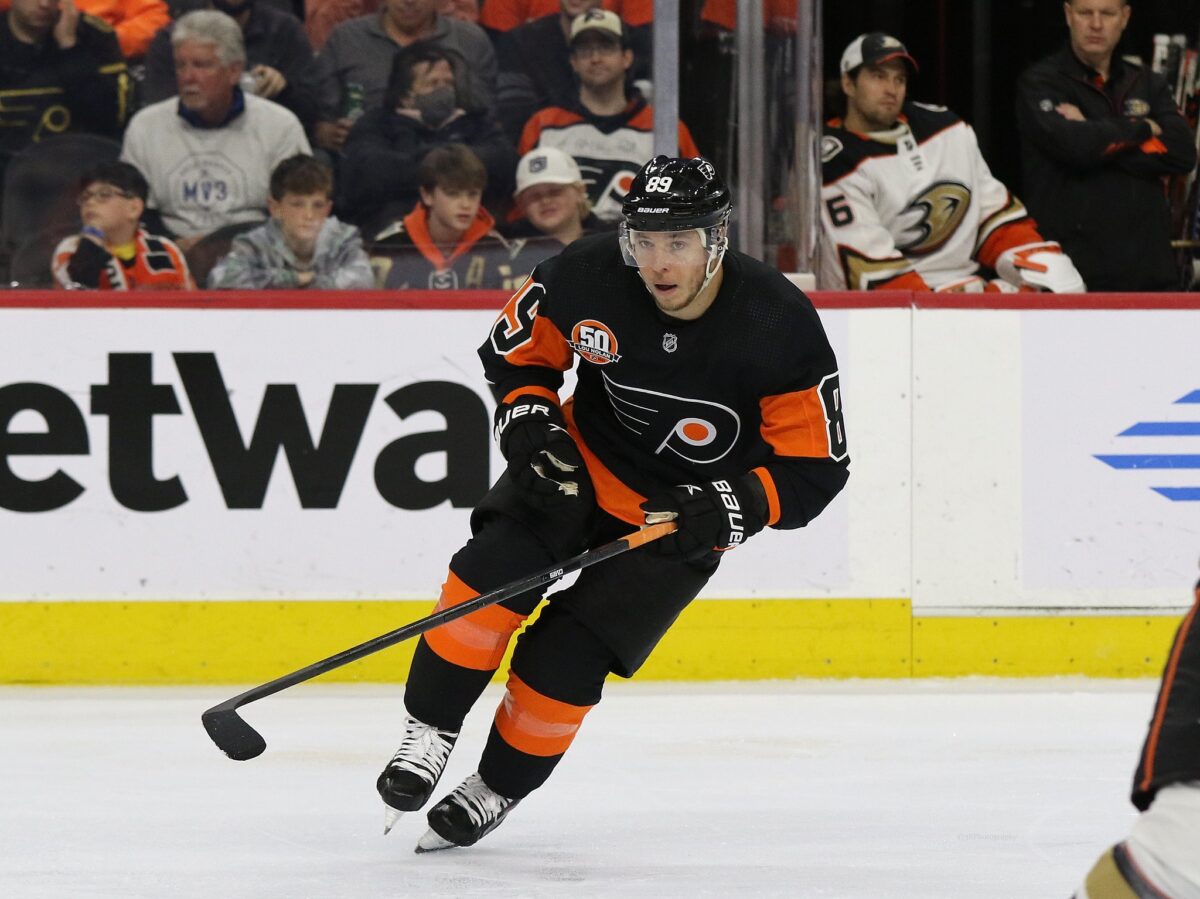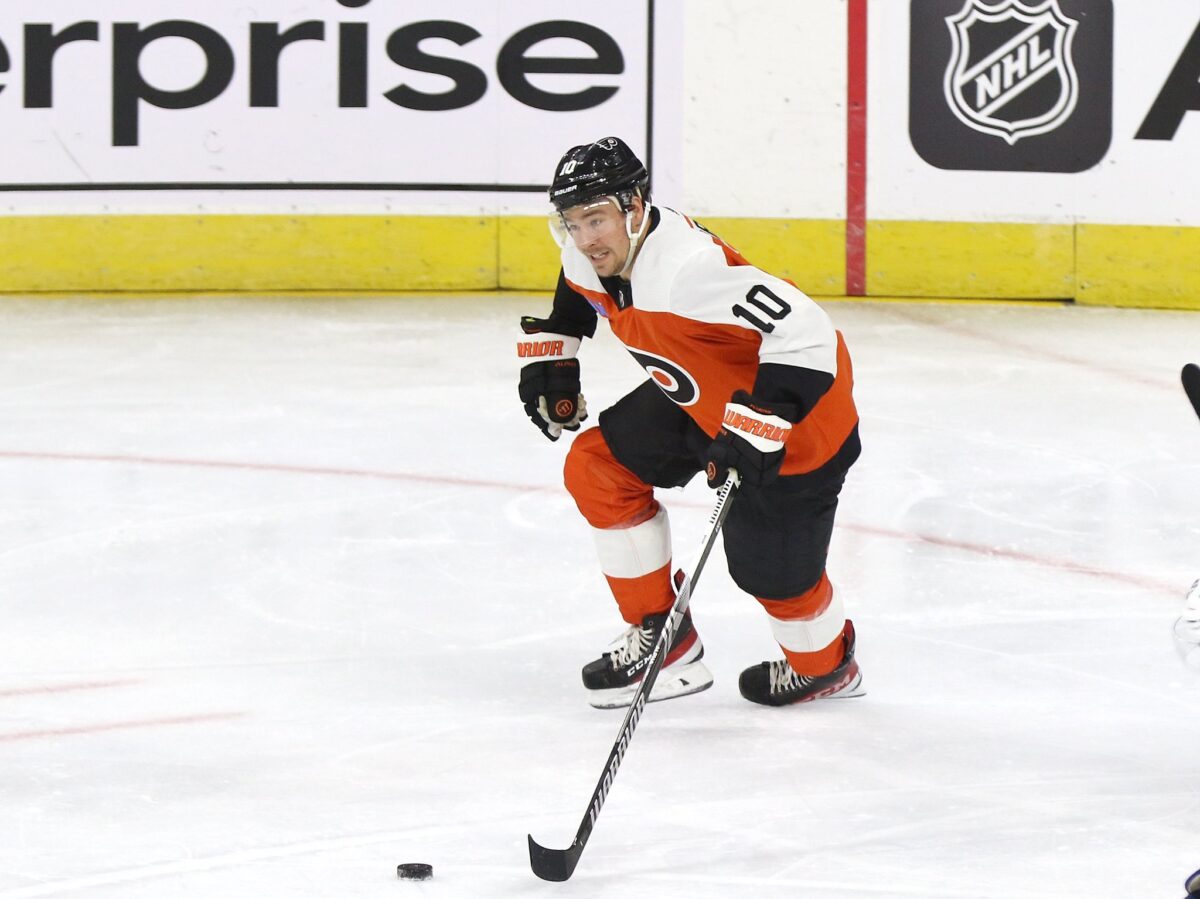It’s never an easy decision to buy out an NHL player, especially one as involved in his community as Cam Atkinson. Unfortunately, that might be the choice the Philadelphia Flyers have to make as they approach the offseason.
Related: Cam Atkinson’s Community Work Deserves More National Attention
Since his return from injury – after missing the entire 2022-23 season – Atkinson has noticeably lost a step. The 34-year-old winger is under contract through the 2024-25 season at a $5.875 million cap hit. A buyout would cost $2.36 million against the cap in 2024-25 and $1.76 million the following season, so the Flyers would be saving some money. Considering his trajectory and the direction the team is headed, management could give him another shot elsewhere by buying out the last season of his deal.
Flyers Are Worse With Atkinson on the Ice
The biggest reason it makes sense to buy out Atkinson’s contract is that the Flyers are a better team without him on the ice, proven by his worst-among-forwards expected goals against per 60 minutes (xGA/60) of 3.01 at even strength, coupled with an expected goals percentage (xGF%) of just 48.1 percent. That’s not great, but it goes deeper than that.

Atkinson’s predominant linemates are Owen Tippett, Joel Farabee, and Morgan Frost, and things get better when he’s not by their side. In 278 minutes at even strength with Tippett, they share a 46.3 percent xGF% versus a much better rate of 51.0 percent when Tippett is by himself. Farabee is a similar story, with a 47.3 percent xGF% in 247 minutes together versus a 51.4 percent rate when the two are separated. As for Frost, it’s an even more stunning difference — in 265 minutes of ice time, their xGF% is 47.9 percent together, while Frost apart from the veteran sits at an impressive 57.6 percent rate.
Atkinson doesn’t pair well with the Flyers’ top-six forwards, so a simple solution would be to play him in the bottom-six – so he can at least play. The issue with that is the Flyers’ third line of Noah Cates, Ryan Poehling, and Garnet Hathaway was formed in early February and has arguably been the team’s best line since. The fourth line has been fairly competitive this season, with players like Bobby Brink, Denis Gurianov, Olle Lycksell, Nicolas Deslauriers, and even more recently captain Sean Couturier thanks to a little wiggle room in the top-nine.
So, unfortunately, that leaves Atkinson on the outside. His even-strength play hasn’t been the best (even if he has 22 points), though he has been used heavily on special teams. But given his salary, it’s not worth it for him to be a sheltered 5-on-5, special-teams-only athlete. It doesn’t make sense for him or the team.
Younger Flyers Can’t Be Blocked From the Lineup
The Flyers’ young players shouldn’t have lineup spots handed to them, as competition ensures that only the very best make it to the NHL. But that doesn’t mean they should be blocked. The issue with Atkinson is that he has consistently received ice time over those who are playing better than him — and youngsters have suffered the most from this.
At this stage, playing Atkinson is hurting a player like Brink’s development, while a player like Samu Tuomaala might not make the team next season, even if he has a good training camp, solely because Atkinson is too established and makes too much money not to be playing.

Despite Atkinson’s shortcomings, he has earned prime ice time this season. Averaging 16:39 a night, he is fourth among forwards, despite that his goal-scoring ranks fifth on the team. That scoring, by far his best asset, has heavily regressed since the early parts of the season – he hasn’t scored since Jan. 25 after suffering a long scoring drought just a couple of weeks before.
Atkinson has had his cold streaks, yet head coach John Tortorella has kept him in the top-six, desperately hoping he can find the magic he’s shown in his past. But that’s not the best recipe for winning hockey games. If young players on a team that is supposed to be rebuilding, no less, can’t get into the lineup regularly and receive ample ice time solely because a veteran who used to be worthy of it is getting it instead, it’s a sign of a poorly run team. That can’t be the Flyers for much longer.
Atkinson Deserves Another Chance
With the criticism of Atkinson’s game out of the way, he still deserves another chance in the NHL. Even if his contract is retained at 50 percent, his cost might still be too much for many teams. So, to give him the best opportunity to find a new home, a buyout makes the most sense.
Even though the Flyers are fine in the money department, burying Atkinson in the American Hockey League (AHL) for the last season of his contract or making him a healthy scratch more often than not wouldn’t be the classy thing to do. Hockey is a business, sure, but if the Flyers care enough about their culture to spend draft capital on veteran rentals at the trade deadline, they know this wouldn’t be the right decision. Atkinson has fought a lot of adversity to still be playing hockey, and as a veteran of 12 NHL seasons, he has earned the chance to bounce back late in his career. His time might be winding down, but wasting a valuable age-35 season shouldn’t happen.
Atkinson could still be a solid player, but that probably won’t happen with the Flyers. At this point, the team and the player should go their separate ways. Using a buyout to make that happen isn’t exactly risk-free, but it does have major benefits. The Flyers should consider pulling the trigger in the offseason.
